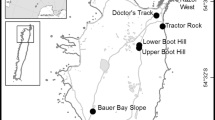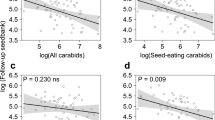Abstract
Weeds persist in rain-fed cereal fields in NE Spain, despite intense herbicide use and high seed removal rates by granivorous harvester ants. Herbicide resistance is involved, but certain weed species also appear to escape seed removal by granivores. To identify the mechanisms involved, we measured seed removal rates (three fields in 2010) and the timing of seed shed (one field in 2009 and three fields in 2010) and used an existing model, which integrates short-term rates of seed shed, burial and removal, to estimate long-term seed removal rates. Averaged over years, fields and weed species, the long-term seed removal rate was estimated at 72 % (range 46–100 %). Fifteen to 25 % of the seeds of Bromus diandrus avoided removal by being less attractive (low removal rates), and another 0–29 % escaped through crop harvest, which made seeds inaccessible to granivores. Similarly, 20–32 % of the Papaver rhoeas seeds escaped through crop harvest, while another 13–17 % escaped by burial into the soil (small seed size). Other species, such as Galium spurium or Diplotaxis erucoides, had no means of avoiding seed removal by harvester ants. In particular, the more troublesome weeds, such as B. diandrus, P. rhoeas and L. rigidum, combined herbicide resistance or tolerance with avoidance mechanisms against granivory.



Similar content being viewed by others
References
Agencia Estatal de Meteorología (2012) Valores Climatológicos Normales. Estación Lleida. http://www.aemet.es/es/serviciosclimaticos/datosclimatologicos/valoresclimatologicos?k=cat. Date of last access: 31 May 2012
Azcárate FM, Kovacs E, Peco B (2007) Microclimatic conditions regulate surface activity in harvester ants Messor barbarus. J Insect Behav 20:315–329
Baraibar B, Westerman PR, Carrion E, Recasens J (2009) Effects of tillage and irrigation in cereal fields on weed seed removal by seed predators. J Appl Ecol 46:380–387
Baraibar B, Carrión E, Recasens J, Westerman PR (2011) Unravelling the process of weed seed predation: seed cache finding, seed utilization and seed preference. Biol Control 56:85–90
Davis AS, Daedlow D, Schutte BJ, Westerman PR (2011) Temporal scaling of episodic point estimates of seed removal to long-term removal rates. Methods Ecol Evol 2:682–690. doi:10.1111/j.2041-210X.2011.00119.x
Díaz M (1992) Spatial and temporal patterns of granivorous ant seed removal in cereal crop areas of central Spain. Oecologia 91:561–568
Escorial C, Loureiro I, Rodríguez-García E, Chueca C (2011) Population variability in the response of ripgut brome (Bromus diandrus) to sulfosulfuron and glyphosate herbicides. Weed Sci 59:107–112
Generalitat de Catalunya (2011) Climatologia, El Pla d’Urgell 1971-2000. Climatologia, L’Urgell. 1971-2000. http://www20.gencat.cat/docs/meteocat/Continguts/Climatologia/climatologies_comarcals/documents/comarques.pdf. Accessed 12 Oct 2010
Genstat 5 Committee (1993) Genstat Release 3 Reference Manual. Clarendon Press, Oxford, United Kingdom
Heap IM (2012) International survey of herbicide resistant weeds. http://www.weedscience.org. Accessed 16 January 2012
Hulme PE, Benkman CW (2002) Granivory. In: Herrera CM, Pellmyr O (eds) Plant-animal interactions. An evolutionary approach. Blackwell Science Ltd, Oxford, pp 132–154
Mohler CL, Frisch JC, McCulloch CE (2006) Vertical movement of weed seed surrogates by tillage implements and natural processes. Soil Till Res 86:110–122
Peart MH (1979) Experiments on the biological significance of the morphology of seed-dispersal units in grasses. J Ecol 67:843–863
Reyes-López JL, Fernández-Haeger J (2002a) Composition-dependent and density dependent seed removal rates in the harvester ant Messor barbarus. Sociobiology 39:475–484
Reyes-López JL, Fernández-Haeger J (2002b) Food storage in the nest and seed selectivity in the harvester ant Messor barbarus (Hymenoptera: Formicidae). Sociobiology 39:123–128
Spokas K, Forcella F, Archer D, Reicosky D (2007) SeedChaser: vertical soil tillage distribution model. Comput Electron Agr 57:62–73
Torra J, Royo-Esnal A, Recasens J (2011) Management of herbicide-resistant Papaver rhoeas in dry land cereal fields. Agron Sustain Dev 31:483–490
Westerman PR, Wes JS, Kropff MJ, van de Werf W (2003) Annual losses of weed seeds due to removal in organic cereal fields. J Appl Ecol 40:824–836
Westerman PR, Liebman M, Heggenstaller AH, Forcella F (2006) Integrating measurements of seed availability and removal to estimate weed seed losses due to predation. Weed Sci 54:566–574
Westerman PR, Dixon PM, Liebman M (2009) Burial rates of surrogate seeds in arable fields. Weed Res 49:142–152
Whitford WG (1978) Foraging in seed-harvester ants Progonomyrmex spp. Ecology 59:185–189
Willot SJ, Compton SG, Incol LD (2000) Foraging, food selection and worker size in the seed harvesting ant Messor bouvieri. Oecologia 125:35–44
Acknowledgments
We wish to thank Barbara Baraibar, Nuria Moix, Sergi Royan, Addy L. Garcia, Jordi Recasens, Daniel Daedlow and Souzi Rafael for field assistance. We also thank Xavier Llobet and Joan Ribes for allowing us to use their cereal fields and for their patience and hospitality. We wish to thank Universitat de Lleida both for funding PhD grant (V. Atanackovic) and funding the part of research which was done in Germany (Group of Crop Health, University of Rostock), and Ministry of Education and Science of Spain (projects AGL 2007-60828 and AGL 2010-22084-C02-01).
Author information
Authors and Affiliations
Corresponding author
Additional information
Handling Editor: Jonathan Lundgren.
Rights and permissions
About this article
Cite this article
Westerman, P.R., Atanackovic, V., Royo-Esnal, A. et al. Differential weed seed removal in dryland cereals. Arthropod-Plant Interactions 6, 591–599 (2012). https://doi.org/10.1007/s11829-012-9211-6
Received:
Accepted:
Published:
Issue Date:
DOI: https://doi.org/10.1007/s11829-012-9211-6




